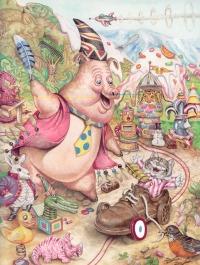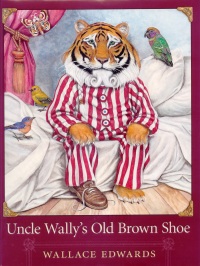| ________________
CM . . .
. Volume XIX Number 12. . . .November 23, 2012.
excerpt:
Wallace Edwards’ new book, Uncle Wally’s Old Brown Shoe, contains the same style of bold, imaginative and weirdly wonderful illustrations that we have come to expect from this highly talented artist. Amongst other awards, in 2002 Edwards won the Governor General’s Literary Award for illustration with the book, Alphabeasts. Edwards is highly regarded for the colourful and creative nature of his work. To walk through Edwards’ illustrations is to walk through a garden of limitless possibilities—a garden from which anything can blossom. In this book, we follow the path of an old brown shoe as it rolls from one busy, action-filled scene to another, encountering a variety of characters as it goes. Uncle Wally is a pyjama-clad tiger, and a button from his pyjama top pops off and sets the shoe in motion. Uncle Wally’s Old Brown Shoe is a cumulative tale inspired by the traditional tale, The House That Jack Built. Each page builds upon, and repeats the information from the page with which it was preceded. 
Edwards’ illustrations were constructed with watercolours, gouache and pencils. It is bright, vibrant, and detailed work. Young readers will be drawn by the highly fanciful, delightfully colourful art. The imaginative illustrations have a dream-like quality about them. One can gaze at them for long periods of time, wondering how it all fits together. In Wallace’s dream-world landscape, anything seems possible, yet, as in a dream, there seems to be an absence of rhyme or reason to those possibilities. Frogs walk on stilts for no apparent reason; a bulldog in a boat plays a musical instrument; a pig in a fancy hat tickles a cat. It seems to me almost as if each illustration is torn from Edwards’ sketch pad—a combination of wildly imaginative, yet disconnected doodles. As the reader, I was left wondering what it all meant. When we read, we most often tend to expect a certain order. Most often, this order is linear. One event logically precedes another. The circular story that leads us in the end back to where we started with Uncle Wally’s old brown shoe perhaps suggests that the expectation of linear progression in the illustrations is inappropriate for this book. As one who likes to make sense of the world, I still found it necessary to search for order and structure to the illustrations. Alas, I could not find it. This is perhaps less of a problem for young readers than it is for me, but I could not prevent myself away from asking, “What does it all mean?” I had hoped to at least be able to find in each illustration a hint of what creature would be the dominant feature of the next illustration. I figured this would add some of that linear patterning for which I was looking. Although such hints could be found in some of the illustrations, it was not evident in all of them. In the inside cover pages, the main creatures that appear in each of the story illustrations are featured. These main creatures are presented in the inside covers in the order in which they appear in the book. Yet, inexplicably, the moth is missing. In essence, for me at least, I found this “near-order” served only to further disrupt the order for which I was looking. I found myself constantly asking, “Why is it so?” and, again, “What does it all mean?” Despite my reservations about the absence of order, I did enjoy the book. The artwork is creative and energetic. The text is humorous and rhythmic. I confess also that I may simply have been a poor choice to review this book—someone with more creativity and imagination may have enjoyed the strengths of the book even more than I did. Someone with greater flexibility in their thinking and less of a need to seek comfort through order might have had less difficulty with what I perceive to be the weaknesses of the book. What I can guarantee is that this book will get the reader thinking. It certainly did for me. Recommended with reservations. Gregory Bryan is a professor of children’s literature and literacy education at the University of Manitoba in Winnipeg, MB.
To comment
on this title or this review, send mail to cm@umanitoba.ca.
Copyright © the Manitoba Library Association. Reproduction for personal
use is permitted only if this copyright notice is maintained. Any
other reproduction is prohibited without permission.
NEXT REVIEW |
TABLE OF CONTENTS FOR THIS ISSUE
-November 23, 2012.
AUTHORS |
TITLES |
MEDIA REVIEWS |
PROFILES |
BACK ISSUES |
SEARCH |
CMARCHIVE |
HOME |
